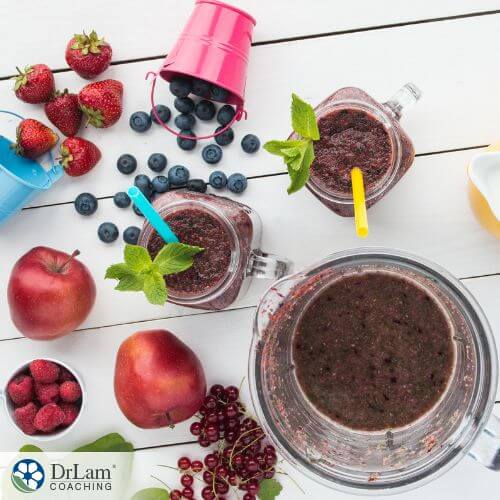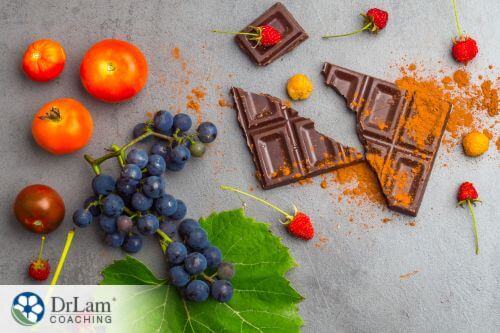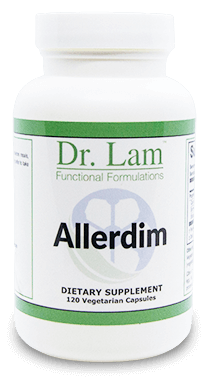 Flavonols are a type of flavonoid that is present in many of the foods that you eat. Cocoa, tea, leafy greens, certain fruits, and beverages are packed with this flavonoid. This compound appears to have several health benefits that can help you to live a longer, healthier life. Improved brain health, lower blood pressure, better heart health, and reduced inflammation, among other benefits, can be had from the compound.
Flavonols are a type of flavonoid that is present in many of the foods that you eat. Cocoa, tea, leafy greens, certain fruits, and beverages are packed with this flavonoid. This compound appears to have several health benefits that can help you to live a longer, healthier life. Improved brain health, lower blood pressure, better heart health, and reduced inflammation, among other benefits, can be had from the compound.
Flavonols are polyphenolic secondary plant metabolites or a type of flavonoid --a naturally occurring compound present in many vegetables, fruits, and beverages. The flavonoid family is separated into several sub-groupings, with the six main classes being:
They are known for their antioxidant and anti-inflammatory properties. Also, they help keep everyday toxins and chronic conditions at bay, according to an article in the journal Food and Chemical Toxicology.
The four primary forms of flavonols are (+)-epicatechin, (-)-epicatechin, (+)-catechin, and (-)-catechin. These forms are referred to as stereoisomers and are naturally occurring. However, through food processing, they can change from one form to another. Flavonols can be linked together to create oligomeric flavonols called procyanidins.
The most common flavonols found in plant-based foods are (-)-epicatechin and (+)-catechin. Additionally, research suggests that (-)-epicatechin is readily absorbed in comparison to the other forms of flavonols. Also, (-)-epicatechin is recognized for its positive cardiovascular and blood vessel benefits.
Quercetin is the most abundant dietary flavonol. Research indicates that it may help prevent colorectal cancer, as well as other cancers. Dr. Lam's Allerdim contains quercetin, bromelain, and stinging nettle, which is great for suppressing histamine load on the body.
Quercetin is present in foods like:
Kaempferol has been shown to prevent the growth of cancer cells while it preserves and protects normal cells.
Good sources of kaempferol include:
Myricetin has beneficial effects against various diseases, such as cardiovascular disease, inflammation, and cancer. Also, according to one study, it possesses cytoprotective, antioxidant, antimicrobial, antiviral, and antiplatelet activities.
Foods that contain myricetin include:
Isorhamnetin may have the potential to protect against cardiovascular and neurovascular disease, and also provide anti-tumor and anti-inflammatory benefits.
It is in foods such as:
Research indicates that flavonols have notable health benefits. Cocoa flavonols, in particular, help support blood vessel health and promote healthy circulation. As such, they support your circulatory system, helping to deliver vital oxygen and nutrients to your organs and tissues. This is essential for your heart health and overall health and wellness.
Additionally, these compounds help with the regulation of cellular activity. Also, they ward off free radicals that are responsible for causing oxidative stress in your body. In doing so, they boost proper bodily function while protecting against stressors and toxins.
Furthermore, as potent antioxidant agents, these also help your body fight off harmful molecules. Additionally, they can help your body to eliminate inflammatory reactions that stem from irritants like allergens, germs, and toxins. This could minimize uncomfortable symptoms.
 Flavonols are present in a variety of foods, but the degree of the compound present varies from food to food. The amount and types of flavonols within particular foods are distinct. This is referred to as the flavonol profile of a food, and it may indicate the presence or lack of health benefits of a food. Also, the effects of flavonols from one flavonol-containing food to another may not be the same.
Flavonols are present in a variety of foods, but the degree of the compound present varies from food to food. The amount and types of flavonols within particular foods are distinct. This is referred to as the flavonol profile of a food, and it may indicate the presence or lack of health benefits of a food. Also, the effects of flavonols from one flavonol-containing food to another may not be the same.
Flavonol-containing foods include:
There are a few precautions to take when consuming flavonols. As such:
Flavonols are generally considered to be the primary polyphenols in cocoa and chocolate. Catechins and tannins are the significant ones present in cocoa, which are responsible for the bitter taste of pure cocoa.
The benefits of cocoa flavonols include the following. They:
However, the form and level of flavonols found in the cocoa bean change and can be destroyed with standard food processing techniques to make cocoa products like chocolate. As such, you should be cautious when looking at chocolate as a good source of this flavonoid.
Certain fruits, vegetables, tea, and wine containing flavonols are linked to slower mental decline. These include apples, broccoli, kale, olive oil, spinach, tomatoes, and pears. However, according to experts, brain benefits are more likely from the synergistic effect of a variety of healthy foods and not a single flavonol.
Flavonols are cytoprotective, suggesting they protect cells, such as neurons, so, there could be a direct impact on cognition. According to a study in Neuroscience & Biobehavioral Reviews, its potent antioxidant action may effectively protect against neural and oxidative damage.
New research suggests that consuming more berries and tea may contribute to slow mental decline with aging. One study followed over 900 adults (average age 81, without dementia) who ate antioxidant flavonols daily for over seven years. It found their rate of cognitive decline slowed by roughly 32%. This was in comparison to people who didn't eat any flavonol-containing foods.
Kaempferol was shown to have the most impact on cognitive decline. Specifically, people who ate the highest amounts of kaempferol-containing foods experienced 0.4 units a decade slower rate of decline. Additionally, people who ate the most myricetin-containing foods had a 0.3 units a decade slower rate of decline Furthermore, those who ate the most quercetin-containing foods had a 0.2 units per decade slower rate of decline. However, isorhamnetin had no impact.
 These anti-inflammatories and antioxidants prevent cell damage in the brain and other organs like the heart and vascular system, kidneys, and liver. However, while the study showed a link between higher amounts of flavonols and slower cognitive decline, researchers couldn’t establish a direct cause-and-effect relationship.
These anti-inflammatories and antioxidants prevent cell damage in the brain and other organs like the heart and vascular system, kidneys, and liver. However, while the study showed a link between higher amounts of flavonols and slower cognitive decline, researchers couldn’t establish a direct cause-and-effect relationship.
Additionally, the foods that the researcher observed as contributing most to slowing mental decline are apples, beans, kale, broccoli, tea, olive oil, spinach, tomatoes and tomato sauce, wine, oranges, and pears.
Still, the key is eating foods that contain a variety of healthy plant compounds or phytonutrients. These include fiber, vitamins, minerals, and plant chemicals like flavonols. Health benefits are more likely when these nutrients work together synergistically. When this happens, you can reduce inflammation, support immune system health, protect and repair cells, and reduce oxidative stress.
Stress is a regular part of everyday living. When your body experiences stress, the NeuroEndoMetabolic (NEM) Stress Response is the first responder. It goes to work increasing cortisol and adrenaline production. Also, stress typically causes your heart rate to increase, muscles to tense, and all bodily functions not deemed necessary for short-term survival to be limited or put on pause. However, when the stress is gone, your body should return to its normal state.
Long-term stress, however, prevents normal function from returning. This can lead to adrenal fatigue. This condition is the non-Addison's form of adrenal dysfunction, where the body's stress response cannot keep up with life's chronic stressors. Adrenal fatigue can result in a collection of symptoms that can critically affect your quality of life. Different bodily systems are impacted, with a variety of symptoms. However, these symptoms may appear to be entirely unrelated to each other. Symptoms of adrenal fatigue may include anxiety, loss of libido, weight gain, fertility issues, irritable bowel syndrome, food allergies, and more.
However, the flavonols in many fruits and vegetables, for instance, may prove beneficial in addressing some of these symptoms of chronic stress. This could be a good addition to an adrenal fatigue support plan. Be careful with overly-stimulating sources of flavonols, however, like cocoa, tea, and red wine, as this can further stress your adrenals.
Flavonols have several health benefits, and side effects are not common.
However, it’s best to avoid foods that you know can trigger an allergic reaction.
Additionally, the risk of possible negative side effects increases when flavonols are consumed in large amounts without medical supervision, particularly if they are in the form of dietary supplements or plant extracts. Excessive amounts have the potential to inhibit key enzymes that play a role in hormone metabolism and may also generate free radicals.
Furthermore, the potential side effects of cocoa flavonols include allergic reactions, gastrointestinal issues, and interaction with medications. Symptoms of an allergic reaction might include hives, itching, or difficulty breathing. Gastrointestinal issues such as bloating, gas, or diarrhea could emerge. Also, cocoa flavonols may interact with certain medications, like blood thinners and antidepressants.
As such, it’s important to speak with your healthcare provider before making any significant dietary changes or taking supplements.
Foods rich in flavonols can help to ward off chronic illnesses, minimize cognitive decline, and boost your general health. They are in a variety of foods, from leafy greens to berries to red wine. If you are looking for ways to improve your overall health, adding flavonol-containing foods to your diet could be a good choice. However, talk to your doctor about taking any supplements.
If you would like to learn about natural foods to reduce your risk of chronic diseases, the team at Dr. Lam Coaching can help. We offer a free, no-obligation phone consultation at +1 (626) 571-1234 where we will privately discuss your symptoms and various options. You can also send us a question through our Ask The Doctor system by clicking here.

Allerdim contains a potent combination of the compounds Quercetin and Bromelain and can help alleviate allergy symptoms.
Martin, María, and Ramos, Sonia. "Impact of Cocoa Flavanols on Human Health." Food and Chemical Toxicology, vol. 151, 2021, p. 112121, https://pubmed.ncbi.nlm.nih.gov/33722594/
Singhal, Sonu, et al. "Molecular Mechanisms Underlying Breast Cancer and Role of Plant Products in Targeted Therapy." Discovery and Development of Anti-Breast Cancer Agents from Natural Products, 2021, pp. 295-351, https://www.sciencedirect.com/science/article/abs/pii/B9780128212776000118
Sokolov, Alexander, et al. "Chocolate and the Brain: Neurobiological Impact of Cocoa Flavanols on Cognition and Behavior." Neuroscience & Biobehavioral Reviews, vol. 37, no. 10, 2013, pp. 2445-2453, https://pubmed.ncbi.nlm.nih.gov/23810791/
The top benefits of flavonols include a cognitive protection, lower blood pressure, boost in heart health, reduced inflammation, destruction of free radicals, and improved digestion. Foods that are rich in this compound include cocoa, tea, berries, cherries, red wine, onions, lettuce, kale, broccoli, shallots, and capers.


Allerdim contains a potent combination of the compounds Quercetin and Bromelain and can help alleviate allergy symptoms.
